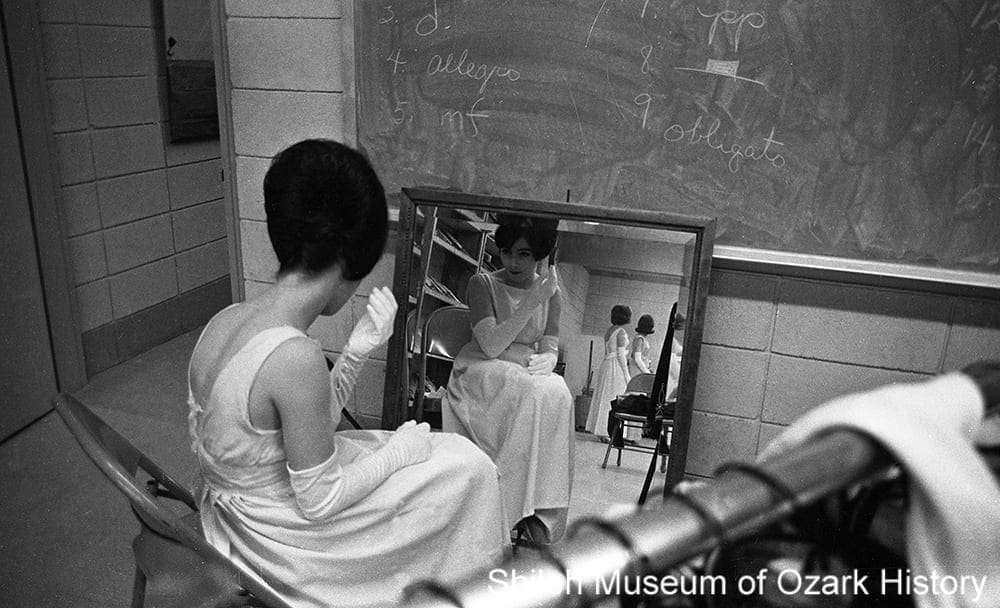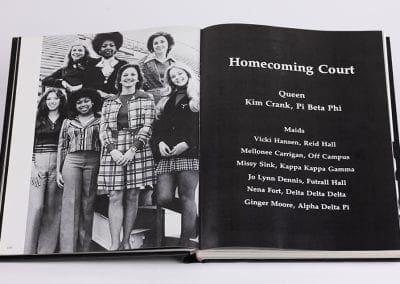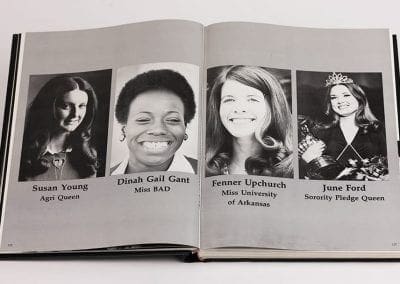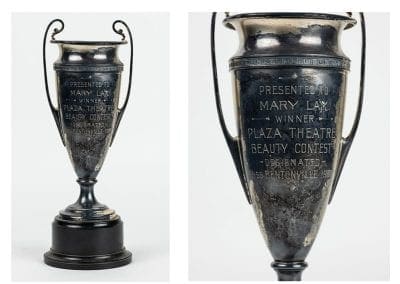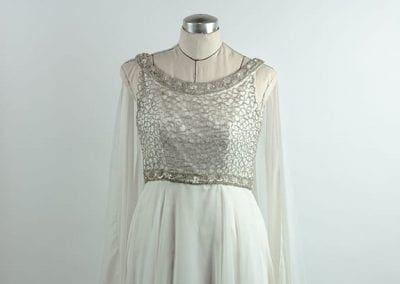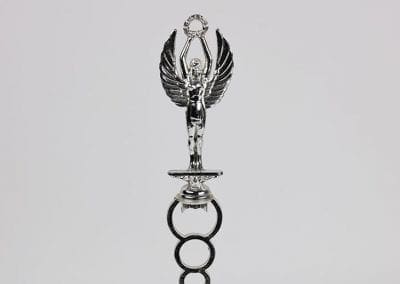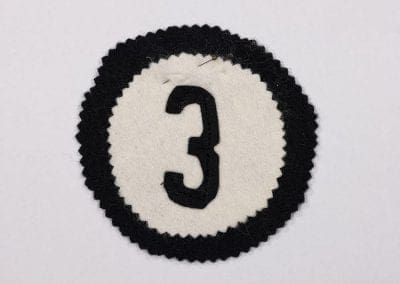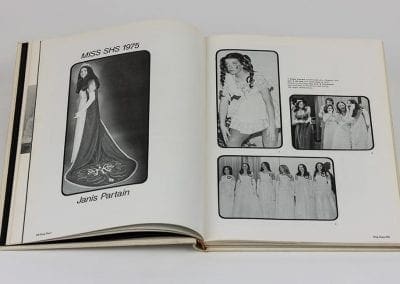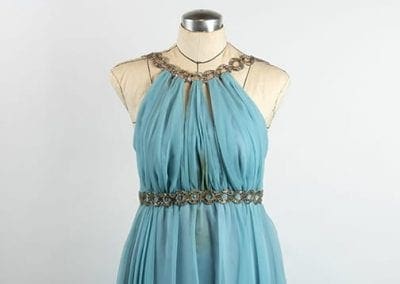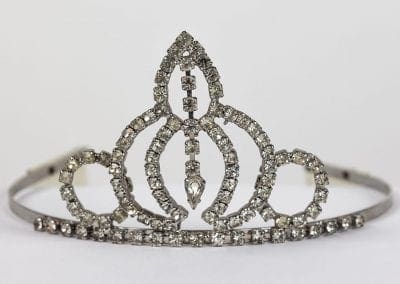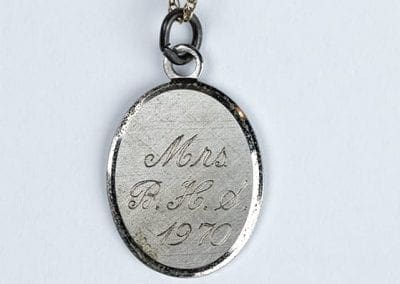Queen for a Day
Online Exhibit
This online exhibit is based on a photo exhibit that on view at the museum through December 12, 2020.
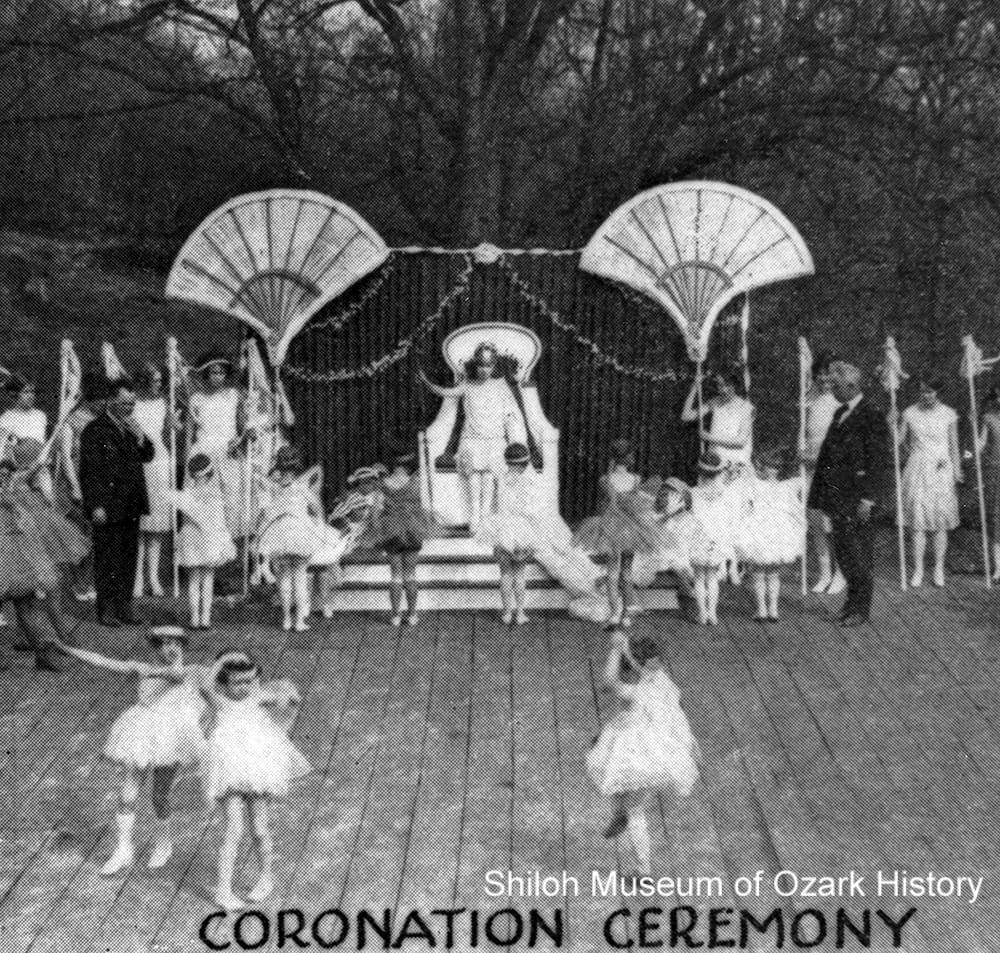
Lillian Ivey of Fayetteville, Apple Blossom Festival Queen 1926, Rogers, April 1926. Held from 1923 through 1927, the festival celebrated the area’s important apple industry through floats, banquets, orchard tours, pageants, and the queen’s coronation. Continued spring rains led to the festival’s cancellation. Siloam Springs Museum Collection (S-83-302-154)
Although there have always been contests to select “the fairest of them all,” the modern beauty pageant began in 1921 when businessmen in Atlantic City, New Jersey, held the first Miss America pageant as a way to encourage tourists to stay beyond the Labor Day holiday. The sixteen-year-old winner of what was essentially a swimsuit competition was described as representing “the type of womanhood America needs—strong, red blooded, able to shoulder the responsibilities of homemaking and motherhood. It is in her type that the hope of the country rests.”
Pageants mean different things to different people. For some, they project the ideals of femininity and beauty, although critics charge that many pageants exclude people based on color, body size, and gender identity. Promoters see them as a way to make money while contestants use them as a stepping stone to educational scholarships, travel, and networking opportunities. States and nations take pride when one of their own is crowned queen. Businesspeople give financial support to pageants as a way to advertise an agricultural product, business, or organization. While an audience sees the pageant as a form of entertainment, feminists believe it disgraces women by valuing them for meeting certain standards of beauty and morality. For the winners, pageants are a way to gain respect and admiration through ambition, talent, and hard work.
Northwest Arkansas has had its share of pageants over the years. One of the first was held during the 1923 Apple Blossom Festival in Rogers, a celebration of the local apple industry. Each community sent a contestant who traveled the parade route on an elaborate, crepe-paper-decorated float. Pageants began to take off after the hard times brought about by the Great Depression of the 1930s and World War II. By the 1950s there were over a dozen local contests, with more on the way. While some pageants celebrated agriculture and livestock industries, many town- and county-based beauty contests were geared towards supplying contestants for the Miss Arkansas competition and the Miss America contest.
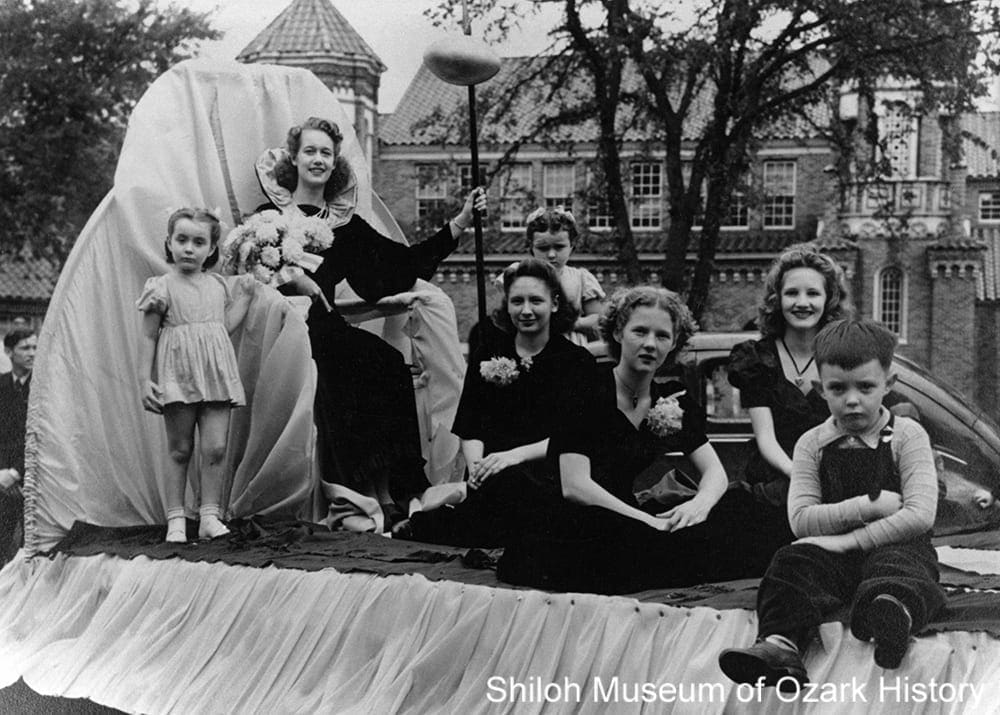
Helen Haxton (seated on throne), Bentonville High School Homecoming Queen 1941, Bentonville, October 24, 1941. With, from left: unidentified, Betty Beck (senior maid), Martha Anne Bair (train bearer, behind Beck), Dorothy Haxton, Mary Grimes (junior maid), and Earl Rife (crown bearer). Helen Haxton Hawkins Collection (S-92-49-15)
Pageants have served as fundraisers. During World War II, candidates for Springdale’s 1944 Homecoming and War Bond queen were “auctioned” off as folks bid on their favorites, buying a total of $208,500 in bonds. In 1951, Washington County Boy Scouts bought 10-cent votes to nominate their teenaged candidates for Queen of Liberty. The money went towards the purchase and installation of a small replica of the Statue of Liberty on the grounds of the County Hospital. Proceeds from the Miss Huntsville 1952 contest were donated to a Red Cross tornado-relief fund to aid victims in nearby White County.
Racial segregation followed by years of discrimination meant that women of color couldn’t—or didn’t—compete in pageants. This was highlighted in 1969, when about 150 African Americans picketed the Miss Arkansas pageant in Hot Springs. One member of the Council for Liberation of Blacks said, “If they have the pageant next year without black women, then they’d better not have it here.” In Northwest Arkansas, barriers broke slowly. Black Americans for Democracy (BAD), an organization founded on the University of Arkansas campus in 1969, aimed to “increase black awareness” at a time when only a small percentage of students were African American. One way was to create the Miss BAD pageant, first won by Linda Hinton in 1972 (the pageant was later renamed as Miss Black University of Arkansas). It wasn’t until the mid-1970s that a few African-American women began competing for the titles of homecoming queen and Miss University of Arkansas. Today, the area’s growing diversity has led to several Latina high school homecoming queens. Some competitions encourage equality in a different way. In 2019, a female impersonator from Rogers won the Miss Gay Arkansas America pageant.
In recent years, pageants have struggled to remain financially feasible and culturally relevant. Nearly one hundred years after its founding, Miss America Organization president and CEO Regina Hopper (Miss Arkansas 1983) helped lead the effort to remove the pageant’s swimsuit competition as a way to rebrand the contest for the 21st century. Today, pageants face a new struggle—the coronavirus pandemic. With limitations on mass gatherings and the uncertainty of the virus’s spread in the future, some local, state, and national pageants have been cancelled.

Lillian Ivey of Fayetteville, Apple Blossom Festival Queen 1926, Rogers, April 1926. Held from 1923 through 1927, the festival celebrated the area’s important apple industry through floats, banquets, orchard tours, pageants, and the queen’s coronation. Continued spring rains led to the festival’s cancellation. Siloam Springs Museum Collection (S-83-302-154)
Although there have always been contests to select “the fairest of them all,” the modern beauty pageant began in 1921 when businessmen in Atlantic City, New Jersey, held the first Miss America pageant as a way to encourage tourists to stay beyond the Labor Day holiday. The sixteen-year-old winner of what was essentially a swimsuit competition was described as representing “the type of womanhood America needs—strong, red blooded, able to shoulder the responsibilities of homemaking and motherhood. It is in her type that the hope of the country rests.”
Pageants mean different things to different people. For some, they project the ideals of femininity and beauty, although critics charge that many pageants exclude people based on color, body size, and gender identity. Promoters see them as a way to make money while contestants use them as a stepping stone to educational scholarships, travel, and networking opportunities. States and nations take pride when one of their own is crowned queen. Businesspeople give financial support to pageants as a way to advertise an agricultural product, business, or organization. While an audience sees the pageant as a form of entertainment, feminists believe it disgraces women by valuing them for meeting certain standards of beauty and morality. For the winners, pageants are a way to gain respect and admiration through ambition, talent, and hard work.
Northwest Arkansas has had its share of pageants over the years. One of the first was held during the 1923 Apple Blossom Festival in Rogers, a celebration of the local apple industry. Each community sent a contestant who traveled the parade route on an elaborate, crepe-paper-decorated float. Pageants began to take off after the hard times brought about by the Great Depression of the 1930s and World War II. By the 1950s there were over a dozen local contests, with more on the way. While some pageants celebrated agriculture and livestock industries, many town- and county-based beauty contests were geared towards supplying contestants for the Miss Arkansas competition and the Miss America contest.

Helen Haxton (seated on throne), Bentonville High School Homecoming Queen 1941, Bentonville, October 24, 1941. With, from left: unidentified, Betty Beck (senior maid), Martha Anne Bair (train bearer, behind Beck), Dorothy Haxton, Mary Grimes (junior maid), and Earl Rife (crown bearer). Helen Haxton Hawkins Collection (S-92-49-15)
Pageants have served as fundraisers. During World War II, candidates for Springdale’s 1944 Homecoming and War Bond queen were “auctioned” off as folks bid on their favorites, buying a total of $208,500 in bonds. In 1951, Washington County Boy Scouts bought 10-cent votes to nominate their teenaged candidates for Queen of Liberty. The money went towards the purchase and installation of a small replica of the Statue of Liberty on the grounds of the County Hospital. Proceeds from the Miss Huntsville 1952 contest were donated to a Red Cross tornado-relief fund to aid victims in nearby White County.
Racial segregation followed by years of discrimination meant that women of color couldn’t—or didn’t—compete in pageants. This was highlighted in 1969, when about 150 African Americans picketed the Miss Arkansas pageant in Hot Springs. One member of the Council for Liberation of Blacks said, “If they have the pageant next year without black women, then they’d better not have it here.” In Northwest Arkansas, barriers broke slowly. Black Americans for Democracy (BAD), an organization founded on the University of Arkansas campus in 1969, aimed to “increase black awareness” at a time when only a small percentage of students were African American. One way was to create the Miss BAD pageant, first won by Linda Hinton in 1972 (the pageant was later renamed as Miss Black University of Arkansas). It wasn’t until the mid-1970s that a few African-American women began competing for the titles of homecoming queen and Miss University of Arkansas. Today, the area’s growing diversity has led to several Latina high school homecoming queens. Some competitions encourage equality in a different way. In 2019, a female impersonator from Rogers won the Miss Gay Arkansas America pageant.
In recent years, pageants have struggled to remain financially feasible and culturally relevant. Nearly one hundred years after its founding, Miss America Organization president and CEO Regina Hopper (Miss Arkansas 1983) helped lead the effort to remove the pageant’s swimsuit competition as a way to rebrand the contest for the 21st century. Today, pageants face a new struggle—the coronavirus pandemic. With limitations on mass gatherings and the uncertainty of the virus’s spread in the future, some local, state, and national pageants have been cancelled.
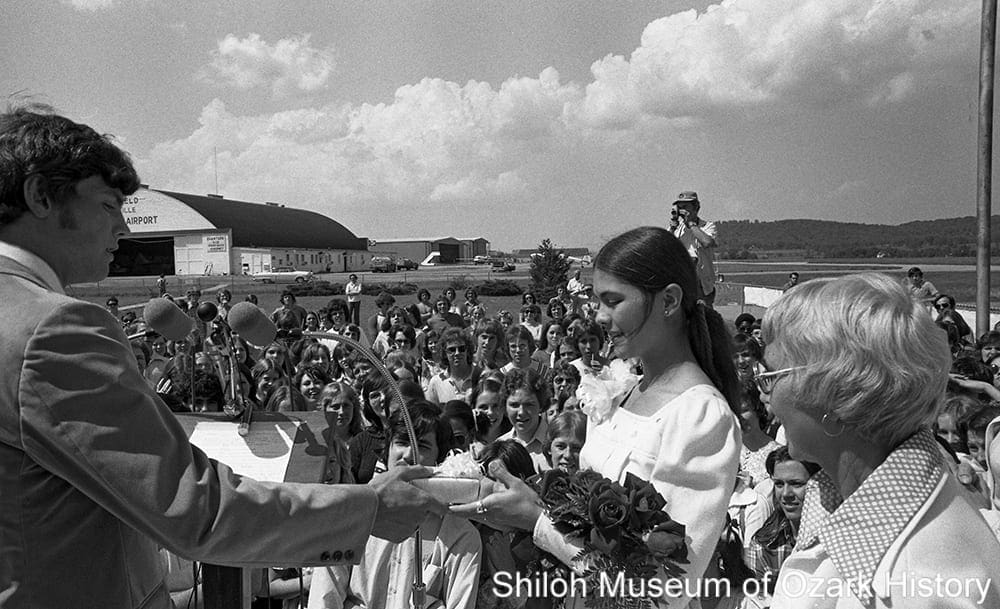
Julie Ann Forshee of Fayetteville receives gifts from well wishers upon her return home after winning the American Junior Miss 1975 title, Drake Field, Fayetteville, May 7, 1975. The seventeen-year-old sprained an ankle while rehearsing her talent number, a dance as a music-box figurine. Forshee won $12,000 in college scholarships. Springdale News Collection (SN 7-7-1975)
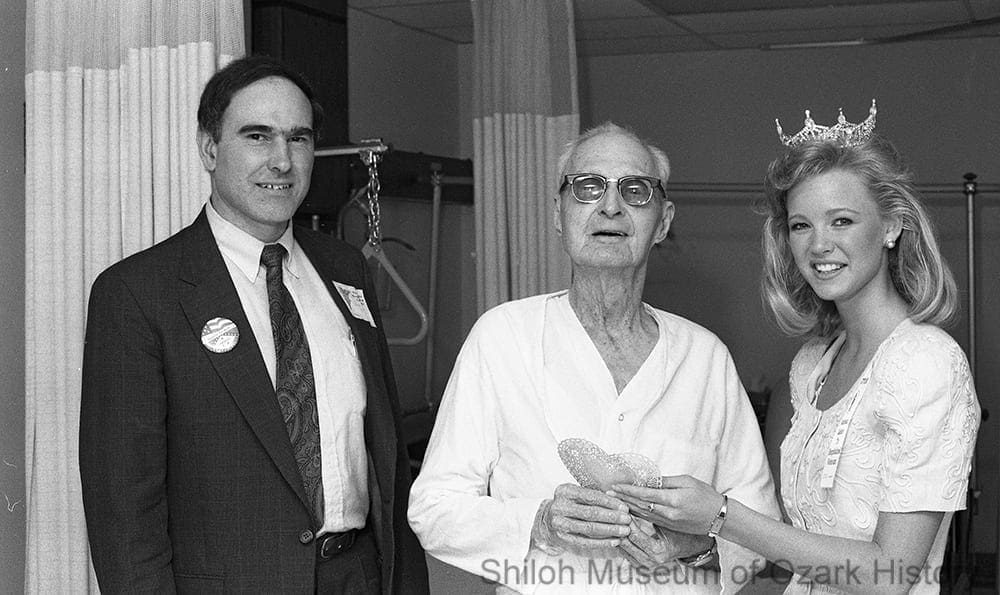
Shannon Boy, Miss Northwest Arkansas 1990, hands a Valentine to Milton Boyd, as part of a “National Salute to Hospitalized Veterans” celebration, Veterans Administration Medical Center, Fayetteville, February 14, 1991. To show his thanks, Boyd sang the song, “Let Me Call You Sweetheart.” With Washington County Judge Charles Johnson (left). Charles Bickford, photographer. Springdale News Collection (SN 2-14-1991)
Artifact Gallery
Yearbook1
Razorback annual featuring the 1974 Homecoming Court, University of Arkansas, Fayetteville, 1975. Back, from left: Missy Sink, Mellonee Carrigan, and Nena Fort. Front, from left: Vicki Hansen, Jo Lynn Dennis, Kim Crank (University of Arkansas Homecoming Queen 1974), and Ginger Moore. This was the first year African Americans were part of the homecoming court. Ann Schumacher Collection (S-2020-3-3)
Yearbook2
Razorback annual featuring Dinah Gail Gant, Miss BAD 1975, University of Arkansas, Fayetteville, 1975. The University group, Black Americans for Democracy (BAD), sponsored the contest to help “increase black awareness” on campus. The title later changed to Miss Black University of Arkansas. Ann Schumacher Collection (S-2020-3-3)
trophy
Trophy presented to Mary Lay, Miss Bentonville 1933, following a beauty contest at the Plaza Theatre, Bentonville, 1933. Mary Lay Johnson Collection (S-82-92)
queen
Dress worn by Janis Partain, Miss Springdale High School 1975, as she competed for the title. Jan Partain Collection (S-2018-2-1)
queen-5
Trophy won by Janis Partain, Miss Springdale High School 1975. The pageant’s trophy and crown came from Tatman’s Jewelry, Springdale. Before the pageant the contestants were invited to a “Coke party” at Tatman’s to view the crown. Jan Partain Collection (S-2019-41-1)
badge
Contestant’s badge worn by Janis Partain, Miss Springdale High School 1975. Jan Partain Collection (S-2019-41-2)
yearbook3
Springdale High School 1975 annual featuring Janis Partain, Miss Springdale High School 1975. Springdale Chamber of Commerce Collection (S-89-117-1)
queen-2
Dress worn by Janis Partain, Miss Springdale High School 1975, when she passed her crown to Miss Springdale High School 1976. Jan Partain Collection (S-2018-2-2)
queen-6
Tiara worn by Juanita Fryer, Mrs. Bentonville High School 1970. Fryer was a Home Economics teacher, honored for her “contributions to the school and her guidance in teaching students.” Lauren Fryer Collection (S-2020-16-2)
Contests and Queens
Agricultural Produce and Fairs
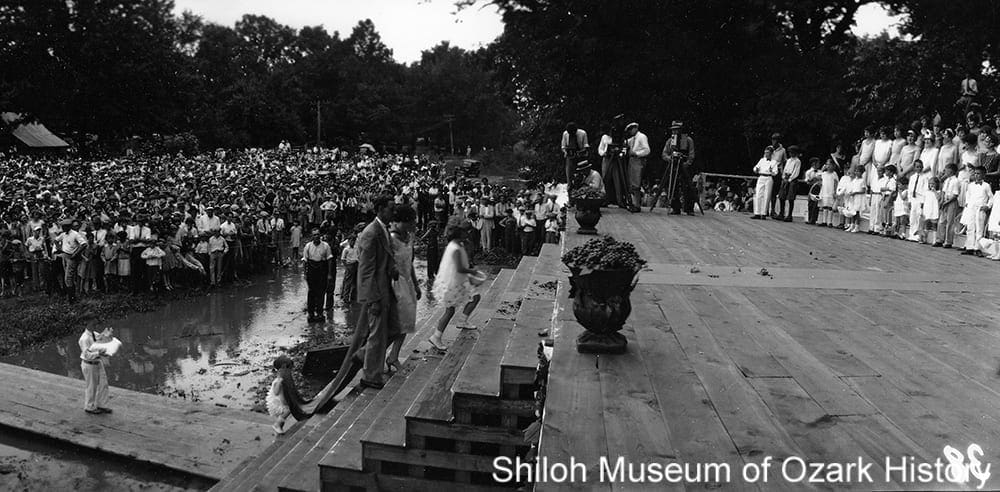
Lavinia Morsani (center left), Ozark Grape Festival Queen 1926, Springdale, August 18, 1926. Escorting her, from left: Jack Joyce (crown bearer), Betty Smitherman Mohney (train bearer), and Martha Montgomery (flower girl). Gene H. Thompson Collection (S-96-56-10)
Ozark Grape Festival Queen
Perhaps, after seeing the success of Rogers’ Apple Blossom Festivals beginning in 1923, Springdale leaders organized the Ozark Grape Festival in 1925 and 1926. Festivities included tours of the Welch Grape Juice plant, band music, a parade, a Mardi Gras Carnival, and speeches by dignitaries such as Governor Tom J. Terral, who also crowned the festival’s queen. She was chosen by a committee led by Springdale lawyer Ulys A. Lovell from among the representatives sent by each neighboring community.
Mary Snapp of Harrison was the 1925 winner. She was crowned in an elaborate ceremony which featured young women in Grecian robes and little girls dressed as purple butterflies, who “flitted before the royal party as it approached the throne.” The queen’s attendants carried white baskets filled with Concord grapes. Her crown was decorated with tinted pearls and a “diamond tiara.” In honor of her achievement, the Springdale Community Club gave her a Ford Coupe automobile. The following year the Club partnered with the Italian community of Tontitown, which grew grapes for Welch’s. Hometown girl Lavinia Morsani was named queen. So much rain fell before the event that Spring Creek flooded, creating a wet, muddy mess which separated the crowd from the stage.
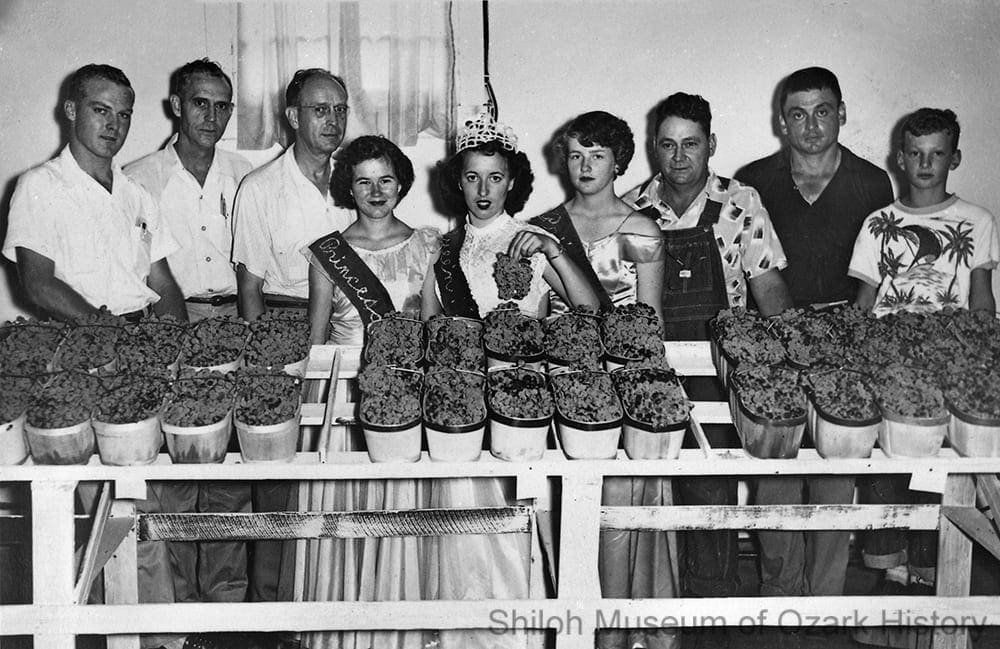
Virginia Franco (center), Queen Concordia 1952, with her maids Betty Lou Ceola (left) and Cathy Beckford, Tontitown, 1952. The men, from left, are Don Dead, Vernon Mathis, J. E. Vail, Enea “Nehi” Morsani, Joe Ranalli, and Franklin Ardemagni. Olivia Cigainero Collection (S-2003-2-539)
Queen Concordia
A group of Italian immigrant farm families settled first in southeastern Arkansas in 1895, but the swampy location proved too harsh. A number of folks, led by Father Pietro Bandini, split off in 1898 and moved to what is now Tontitown. In celebration, the settlers held a community picnic complete with a spaghetti dinner and a Catholic mass. As word spread, the annual event grew to include out-of-town guests, ice-cream stands, speakers, games, music, and a bake sale. Eventually known as the Tontitown Grape Festival, today it’s a multi-day event featuring such things as carnival rides, a book sale and bazaar, musical performances, a car raffle, and a fried chicken and spaghetti supper.
A daughter of those first settlers became the first Queen Concordia, named after the Concord grapes grown on area farms. In 1932 seventeen-year-old Albina Mantegani Gasparotto won the crown by collecting items for the bazaar and selling the most dinner tickets. Because of the hardship caused by the Great Depression and World War II, no further queens were crowned until 1947, when Elsie Mae Fiori won. For much of the festival’s history, contestants were members of St. Joseph Catholic Church. Today any young woman can enter, provided she sells enough raffle tickets to qualify. Sadly, there will be no queen in 2020, as the festival was cancelled because of the ongoing COVID-19 pandemic.
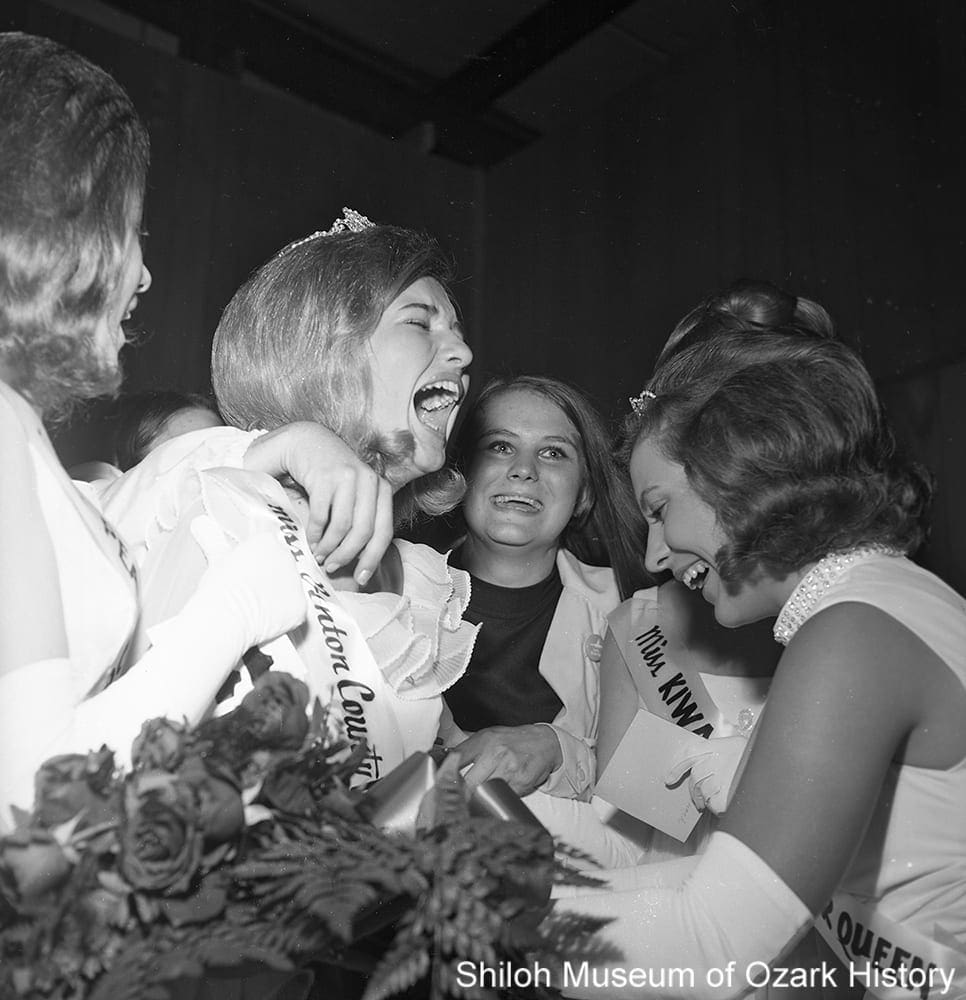
Cathy Horton, Miss Benton County Fair 1969, Bentonville, September 16, 1969. Horton was a Bentonville High School junior who had previously won the Miss Rotary title. With an attendance of more than 1,000, it was the largest crowd in some time. Northwest Arkansas Times Collection (NWAT Box 20 69.15)
Miss County Fair
Northwest Arkansas’s strong agricultural economy led to the founding of several horticultural, agricultural, and mechanical fairs, beginning with the area’s first, held in 1856 in Fayetteville. Most early fairs were short-lived due to financial loss, rain, and low public interest. Over time some evolved into today’s county fairs. While early fairs featured horse races, baseball games, and such novelties (for the time) as moving pictures and airplane demonstrations, the backbone of today’s fairs continue to be livestock shows, craft and food contests, carnival rides, performances, and the queen pageant.
Contestants during the 1961 Benton County Fair were judged in three fashion categories—jeans, street dress, and formal attire—as well as “personal interviews and appearance on the stage.” They weren’t required to wear swimsuits, unlike the girls at Washington County’s 1962 fair. In later years, the Miss Benton County Fair contest became a scholarship pageant open to county high school (or homeschool) senior girls. Today’s contestants are judged by interviews and in fitness, casual, and evening gown competitions. County fair winners went on to the state contest, including Leslie Ann Wilkins of Jasper, Miss Newton County Fair 1976. She became Miss Arkansas State Fair 1976 at age sixteen.
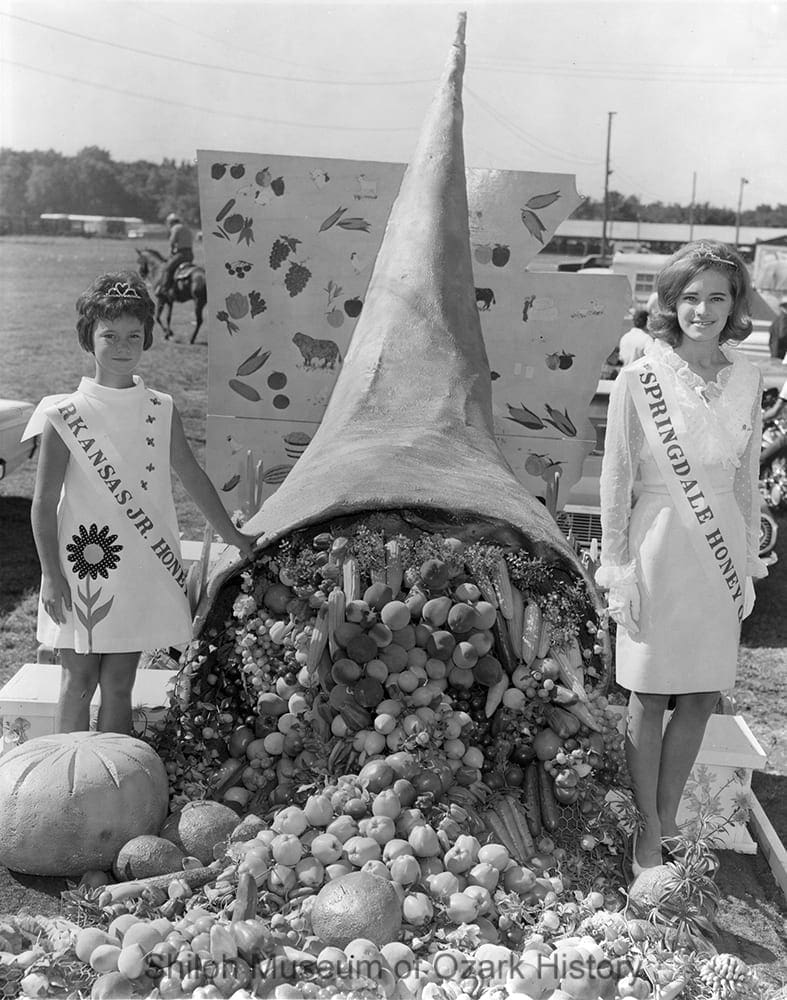
Janis Barnes (right), American Honey Queen 1968 (and former Springdale Honey Queen) with the Arkansas Junior Honey Queen, Springdale, 1968. Springdale News Collection (S-2000-133-601)
Honey Queen
In 1962 the Northwest Arkansas Beekeepers Association selected a runner-up from the Miss Benton County Fair pageant to serve as their first Honey Queen. She was judged for her knowledge of home economics, appearance, and personality. Queens were chosen from runners-up at other county fairs to compete in the statewide competition, including Linda Santa Cruz of Berryville, who was named Arkansas Honey Queen 1966 and who went on to become American Honey Queen 1967. As a representative of the American Beekeeping Federation, she made appearances at state fairs, food fairs, and at an international meeting of beekeepers. She also had the honor of handing the crown to American Honey Queen 1968, Janis Barnes of Berryville.
Livestock Industries
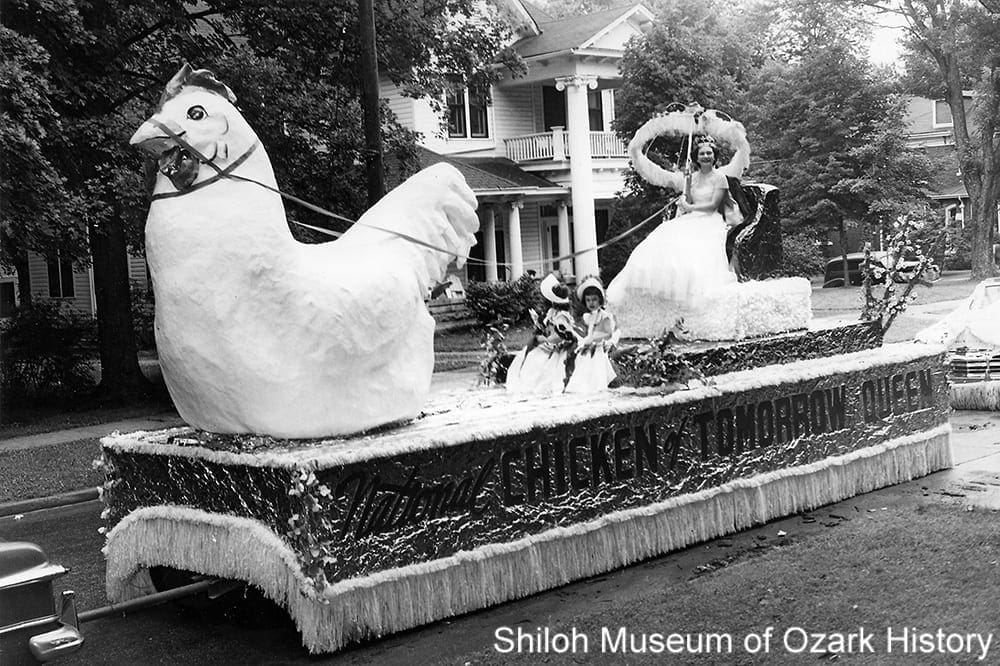
Joan Walters, Chicken-of-Tomorrow Queen, Fayetteville, June 15, 1951. Roy’s Photo Shop, photographer. J. Dickson Black Collection (S-92-142-3)
Chicken-of-Tomorrow Queen
The Chicken-of-Tomorrow contest was a three-year national competition sponsored by the A&P grocery-store chain to encourage chicken breeders to develop a broad-breasted chicken with the white meat American consumers wanted. The contest ended in 1951, when the winner was announced during a week-long celebration in Fayetteville. Events included educational talks, exhibits, dances, concerts, a chicken barbecue, a parade, and a queen competition.
Communities statewide held pageants to select a young woman to compete for the Chicken-of-Tomorrow crown. Joan Walters of Rogers was the winner. Following the crowning ceremony, a Queen’s Ball was held at the University of Arkansas Field House (then a smaller version of Razorback stadium). Two days later the new queen paraded around town in an elaborate float featuring a giant papier-mâché chicken.
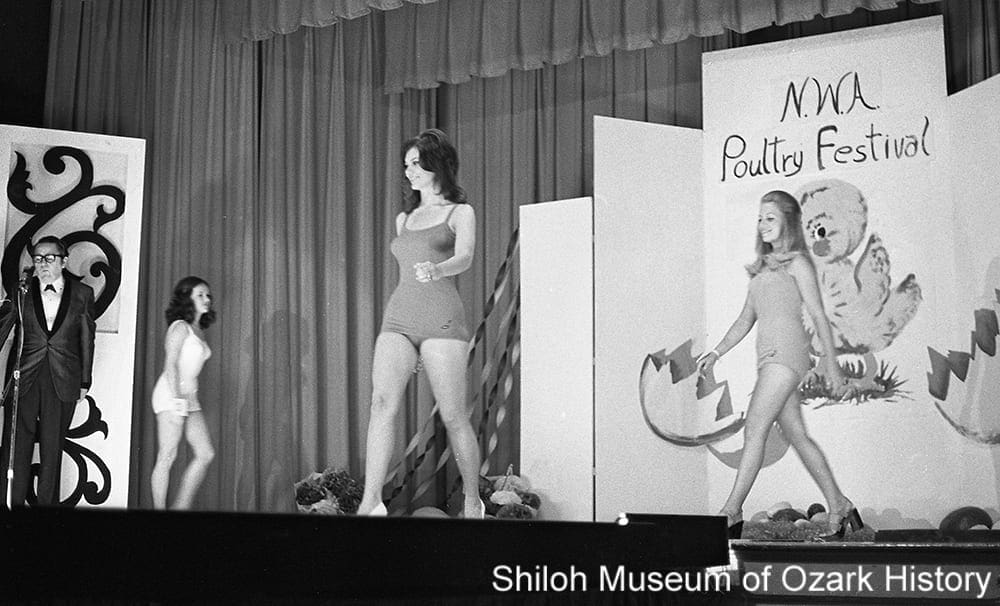
Northwest Arkansas Poultry Princess contestants, Springdale, April 23, 1973. Jerry Biazo, photographer. Springdale News Collection (SN 4-23-1973)
Northwest Arkansas Poultry Princess
First held in 1960, the Northwest Arkansas Poultry Festival was one of several district festivals sponsored by the Arkansas Poultry Federation as a way to “gain more respect and prestige for the . . . poultry industry . . . and to promote increased consumption of poultry and poultry products.” Activities included fried-chicken suppers, parades, and a beauty pageant. Four women were awarded the title Poultry Princess, making each eligible to compete against other district princesses for the state title. For a few years in the early 1960s, the winner of the state contest represented Arkansas in the Miss Universe Pageant.
The last festival was held in 1976. The following year, the Federation cancelled the district festivals in favor of the state contest in Hot Springs. Lee Zachary, executive vice-president of the Springdale Chamber of Commerce, approved the decision, saying the festivals “ . . . cost a lot of money and took a great deal of time and effort. They had become a losing project financially.” Rather than competing in a local pageant, poultry growers, suppliers, and other members of the local poultry industry sponsored their own candidates in the state pageant.
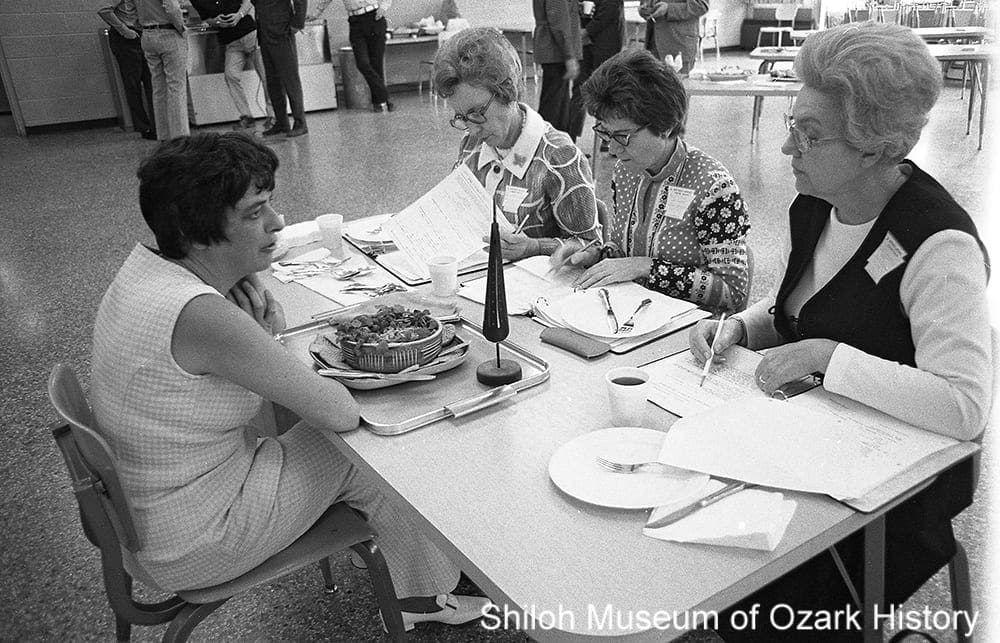
A Chicken Cookin’ contestant tells the judges about her entry, Springdale High School, Springdale, April 21, 1973. The winners were Donna Charlesworth, Gabriele Schafer, Mrs. Ronald Jefferson, and Mrs. James Shreve. Northwest Arkansas Times Collection (NWAT Box 12 65.8A)
Northwest Arkansas Chicken Cookin’ Queen
A Chicken Cookin’ contest was also part of the Northwest Arkansas Poultry Festival. Sponsored by area businesses, competitors met in the Springdale High School cafeteria to cook fanciful meals. Over the years entries included Feather-light and Henpecked Pound Cake, Drumstick Crown, Henny Penny Pizza, Chicken in a Nest, and Breast of Chicken Magnifique. Four women were pronounced winners and each could compete in the state contest. The Arkansas Chicken’ Cooking Queen and Miss Arkansas Poultry Princess toured the country, promoting the poultry industry.
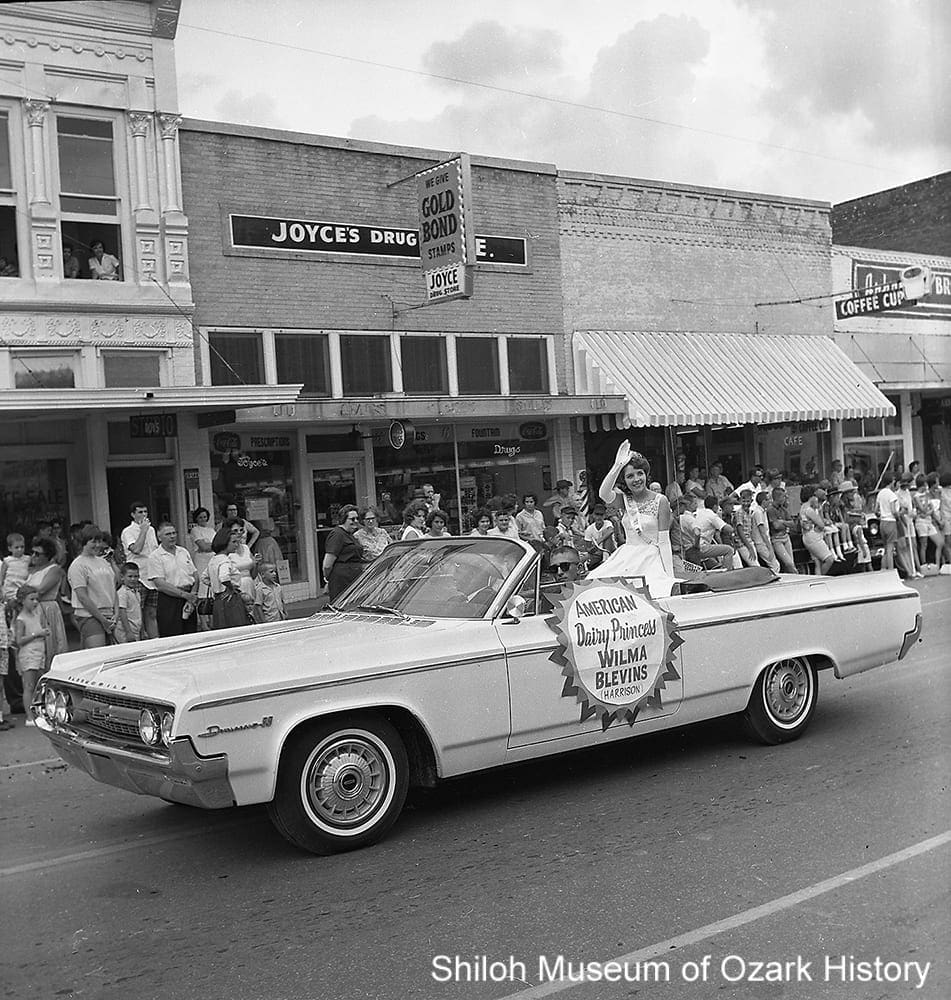
Wilma Lea Blevins, American Dairy Princess 1964, Rodeo of the Ozarks Parade, Springdale, July 2, 1964. Springdale News Collection (SN Pre-65-31)
Dairy Princess
In 1961 members of the Huntsville Rural Development’s Dairy Project met to discuss the selection of a county Dairy Princess as part of a Dairy Foods promotion campaign during Dairy Month. “Any girl between the ages of 16 and 25, with a dairy background, who has never been married, [was] eligible.” At a similar event in Benton County, contestants were judged for their “healthy appearance and natural attractiveness, dairy farm background, public speaking ability, and personality.” Winners went on to compete at a state level, with those winners competing for the national title, first offered in 1955.
One local young woman rose to the top. Born and raised in Bergman (Boone County), Wilma Lea Blevins learned to milk cows by age five on her parents’ dairy farm. After becoming Agri Queen at the University of Arkansas, she won the Arkansas Dairy Princess title in 1963. The following year she competed in the national American Dairy Princess pageant in Chicago. Blevins was so stunned when she was pronounced the winner that she couldn’t remember later what happened on stage. She received a $1,000 scholarship and a wardrobe to use as she traveled the country on a year-long tour as a dairy industry spokesperson.
Schools
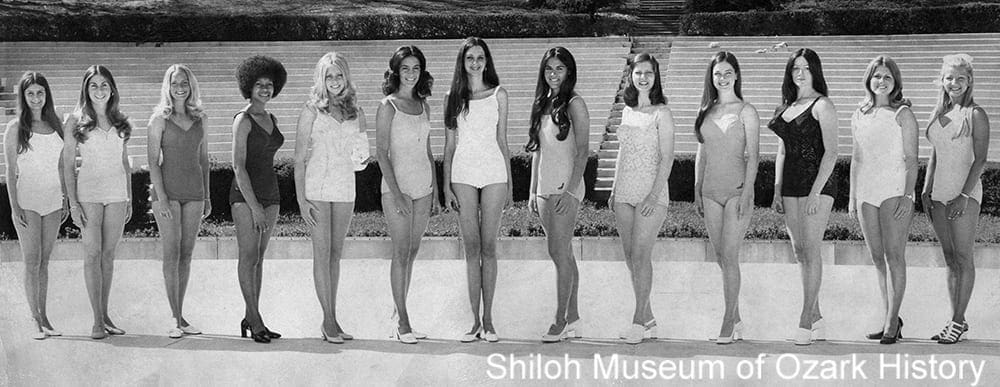
Miss University of Arkansas contestants, Fayetteville, April 1973. From left: Trudy English (Miss University of Arkansas 1973), Shelly Fischer, Jan Hudson, Carolyn Rhodes, Patty Culpepper, Kathy Blakely, Britt Crews, Patsy Bolin, Jan Pettigrew, Jan Wallace, Dawn Winter, Kathy Dye, and Susie Robinson. Springdale News Collection (S-98-31-992)
Miss University of Arkansas
The GAEBALE festival started on the University of Arkansas campus in 1947. Pronounced a bit like “jubilee,” the term contained the first letters of the colleges and schools on campus—Graduate, Arts & Sciences, Education, Business, Agriculture, Law, and Engineering. A beauty contest was introduced in 1952, with contestants representing their sorority or dormitory. The young women were judged in the usual categories plus a swimsuit competition. In 1964 Karen Carlson’s winning physique was detailed in the local newspaper as “…5 feet7½ inches, weight 125,…measurements of 36-23-35.”
In April 1972 the campus Student Union cancelled the beauty contest in part because of finances, low interest, and lack of a pageant director. The newspaper suggested that “…beauty pageants don’t have the same kind of zowie and pizzazz that they used to.” In the end, two fraternities and another sponsor held the contest with a field of fourteen candidates, all of whom were white. It’s unclear when the first African-American students were encouraged to participate, but it may have been in 1973, when Carolyn Rhodes of Camden was a contestant. Patrisha Young, who won the Miss Black University of Arkansas title during the 1981-1982 school year, was also a contestant in the Miss University pageant in 1985. The contest was cancelled in 1993 because Campus Activities Center staff “expressed concern that the pageant’s restrictions were discriminatory.” It resumed in 2007 but it is unclear if there ever was a black Miss University of Arkansas.
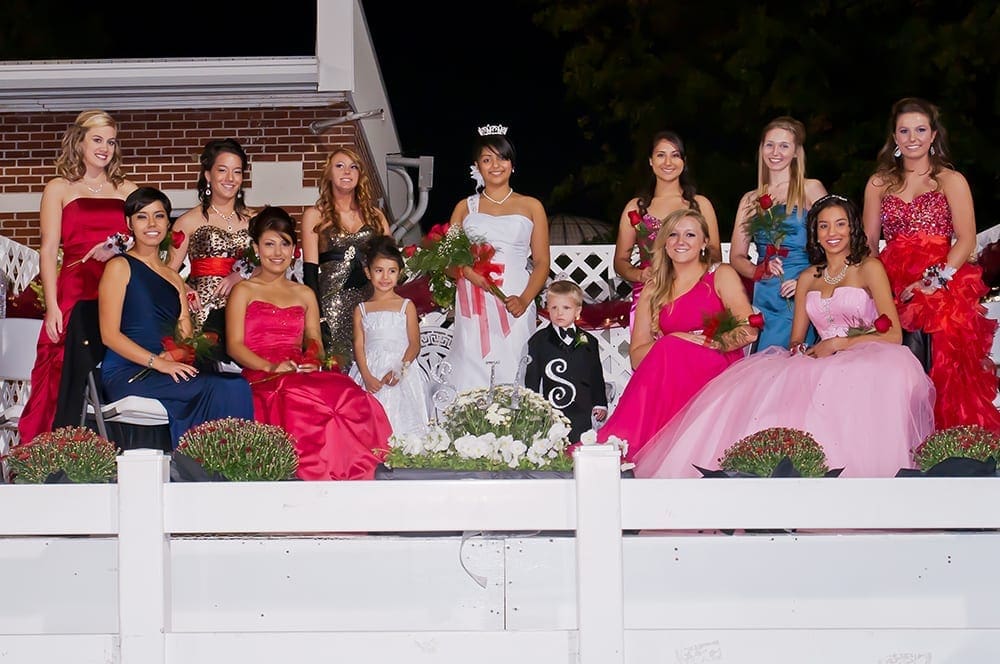
Danai Bahena (center), Springdale High School Homecoming Queen 2011, and her court, Springdale, October 16, 2011. Back, from left: Cassidy Riggins, Laura Worthen, Johnnielynn Pace, Magnolia Bahena, Tamika Davis, and Madeline “Maddie” Poellot. Front, from left: Ariana “Aj” Zaldivar, Brenda Castillo, Evelyn Bahena, Konnor Kirk, Lindsey Parker, and Gabriella “Gabby” Vega. Cynthia Hutchinson, photographer. Courtesy 5H Photography and Danai Bahena Obispo
Homecoming Queen
Each fall, high schools, colleges, and universities celebrate homecoming with activities such as parades, football games, dances, parties, music, and the selection of a homecoming queen. Racial segregation followed by years of discrimination often meant that, if a school had women of color as students, they were left behind when it came time to choose homecoming candidates. That began to change slowly beginning in the 1970s, when two African-American women were selected to be part of the University of Arkansas’ 1974 homecoming court. In 1982 Merike Manley became the University’s first African-American homecoming queen. She was followed by Karen Mathis in 1986, Monica Jones in 1993, and Kimberly Smith in 2009.
As area population diversified, more women of color were represented at homecomings. In 2011, Danai Bahena was surprised to learn that the football players at Springdale High School had nominated her for homecoming queen. Her win was personally significant. As the oldest daughter of five, and the first Latina to win the honor, she felt like she represented a new generation. Her sister, Magnolia, was a homecoming maid in her sophomore, junior, and senior years.
City, State, National
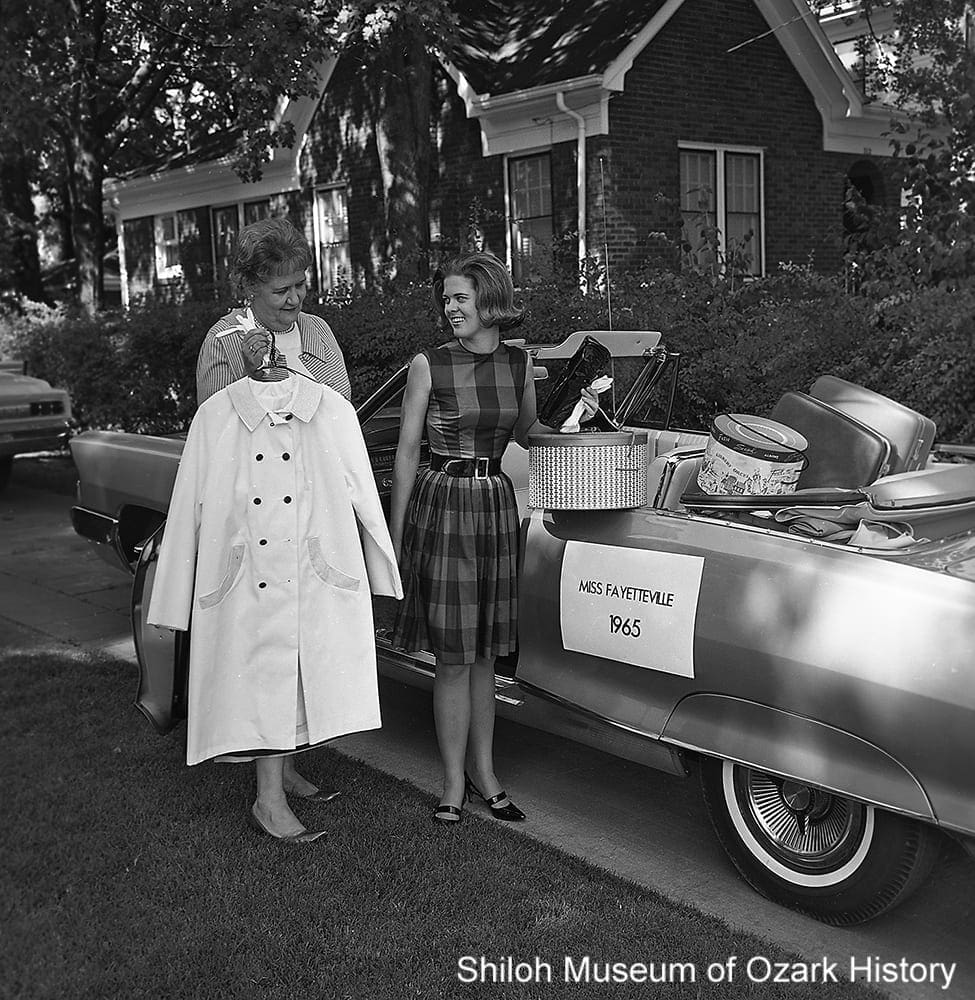
Elizabeth “Betsy” Bridenthall (right), Miss Fayetteville 1965, receives gifts of clothing, luggage, and the keys to a new car, Fayetteville, April 1965. Northwest Arkansas Times Collection (NWAT Box 12 65.8A)
Miss Fayetteville
For a community, beauty pageants were part entertainment, part fundraiser, and part bragging rights. In a June 1950 opinion column in the Northwest Arkansas Times, the author chided Fayetteville for its lack of a pageant, saying, “Why not take part in the [Miss Arkansas pageant] and cop a little favorable publicity? If our representative wins, we receive favorable nationwide attention.” He needn’t have worried. The popularity of pageants grew tremendously in the 1950s. Civic organizations such as the Lions Club, the Kiwanis Club, and the Jaycees sponsored contests for Miss Huntsville, Miss Rogers, Miss Washington County, Miss Pea Ridge, Miss Madison County, and the like.
Pat Moore, Miss Fayetteville 1952, received a two-day, expense-paid trip for herself and a chaperone to the state pageant as well as “ . . . $10 worth of dry cleaning; [a] pair of nylon hose; a box of chocolates; and a supply of cosmetics.” Event proceeds went to the purchase of two scoreboards and clocks for the high school’s new gymnasium. In addition to the traditional pageant competition categories, each contestant had three minutes to display a talent, whether it was “singing, dancing, playing a musical instrument, dramatic reading, art display, dress designing, etc., or she may give a . . . talk on the career she wishes to pursue.” Elizabeth Bridenthal won the 1965 competition before a crowd of six hundred. She sang selections from the operas Madame Butterfly and Gypsy.
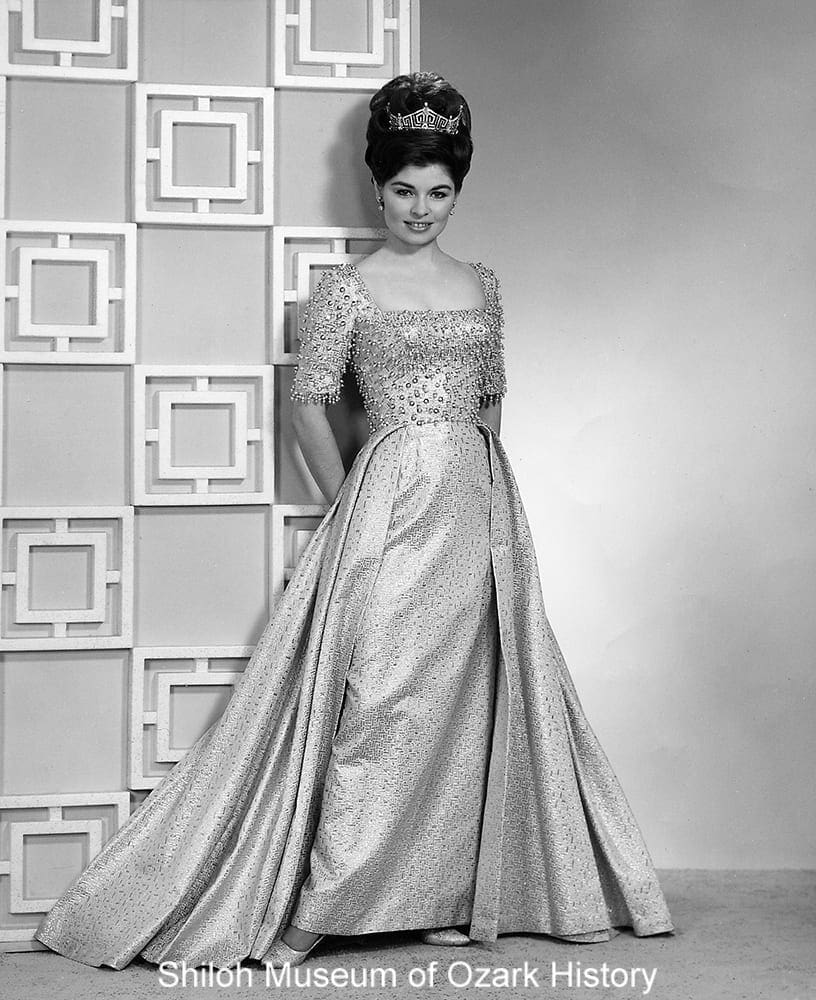
Donna Axum, Miss Arkansas 1964, Fayetteville, 1964. Bob’s Studio, photographer. Springdale News Collection (S-2000-26-820)
Miss Arkansas and Miss America
A native of El Dorado, Arkansas, by 1963 University of Arkansas senior Donna Axum had already won several contests—Poultry Princess, National Cotton Picking Queen, and Arkansas Forest Queen—when she was awarded the title of Miss Arkansas. She credited her win to a last-minute gamble. When told the judges didn’t like her hairstyle, she changed it to a bouffant, a large, rounded hairdo. With her next contest in sight, she said, “You just don’t ever dream of being the top girl in the Miss America pageant. Just being there is enough.” But with hard work and determination her dream came true. She was crowned Miss America 1964. The following year she was an honored guest at many local pageants, boosting local attendance.
In 2017, Axum reached out to Savannah “Savvy” Shields of Fayetteville, the second University student to be crowned Miss America. In addition to wise advice, she gave her Miss America ring to Shields, as a “reminder of what being Miss America was about.” After her win Shields spent the next year making appearances in forty-eight states, living out of “two very overweight suitcases.” She received $90,000 in scholarship money. Another local who made it to the national stage was Ashton Campbell of Hindsville. After winning Miss Arkansas 2014, she placed third in the Miss America pageant. Unfortunately, the 2020 state competition was cancelled because of the coronavirus pandemic, as was the national pageant, which would have celebrated its one-hundredth anniversary.

Iman DeMarco, Miss Gay Arkansas America 2019, Oklahoma City, September 2019. Carrie Strong, photographer. Courtesy Carrie Strong, Miss Gay Arkansas America, and Iman DeMarco
Miss Gay Arkansas America
In 1971 Jerry Peek of Nashville created the Miss Gay America pageant to recognize the best female impersonators/entertainers in the country. Patterned after the Miss America pageant, the original contest featured evening gown, interview, and talent categories. The pageant’s first winner was Norma Kristie of Arkansas. The Miss Gay Arkansas America pageant was established in 1972.
After winning the preliminary pageant, Miss Gay Sweetheart Arkansas America, in 2019 Iman DeMarco of Rogers won the state title. “As a Latino and a father of two, winning was such an accomplishment and gratifying. Being a part of such a prestigious pageant . . . helps by bringing hope to many. . . . As Miss Gay Arkansas I want to be the one who inspires . . . and pushes many beyond their limits. We have everything in our power to be our future, to do and be anything we want.” Although she didn’t win the national competition, she uses her skills to conduct workshops for hopeful contestants. Through her work with the Bentonville Follies, an annual charity drag-show contest, she has helped raise money for Northwest Arkansas charities, including $104,000 for the Arkansas Crisis Center, a nonprofit organization offering “ . . . helpline services to teens in crisis.”
Miscellaneous
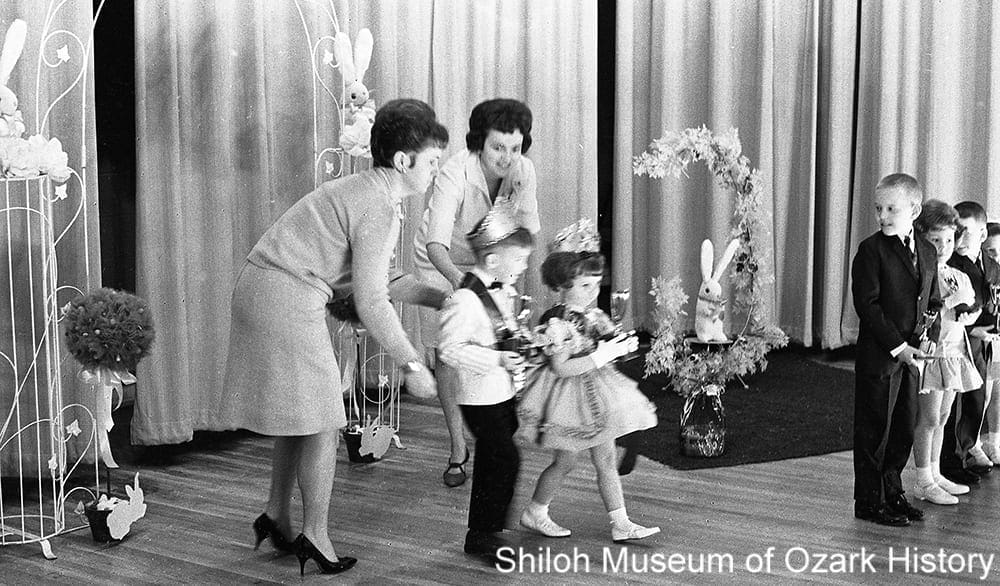
Mark Munger (left) and Kimberlee Jo Campbell, Little Mr. and Miss Springdale 1967, Springdale, March 17, 1967. With, from left: Timmy Janke and Rebecca Lynn Pendergraft (2nd runners-up) and Earl Fears Jr. and Lisa Kay Sullivan (1st runners-up). Jim Morriss, photographer. Springdale News Collection (SN 3-1967 #40)
Mr. and Miss Tiny Tot
Contests for children have been around since at least the 1950s and often are paired with pageants for young women. Many are sponsored by organizations such as the Jaycees or the Lions, civic clubs which use the contests to raise funds for their charitable programs. There are contests for babies, toddlers, and young boys and girls, many with fanciful names. In the 1960s Madison County had categories for King & Queen Baby, Prince & Princess Tot, and Senior & Junior Princess, while the Benton County Fair had Little Miss Tiny Tot and Miss Tiny Tot. The Springdale Jaycettes, the women’s offshoot of the Jaycees, organized a pageant with a more grown-up sounding name—Little Mr. and Miss Springdale. In 1952 the winner of Fayetteville’s contest received “…$3 worth of ice cream, a cosmetic set, a beach ball, and a swim toy.”
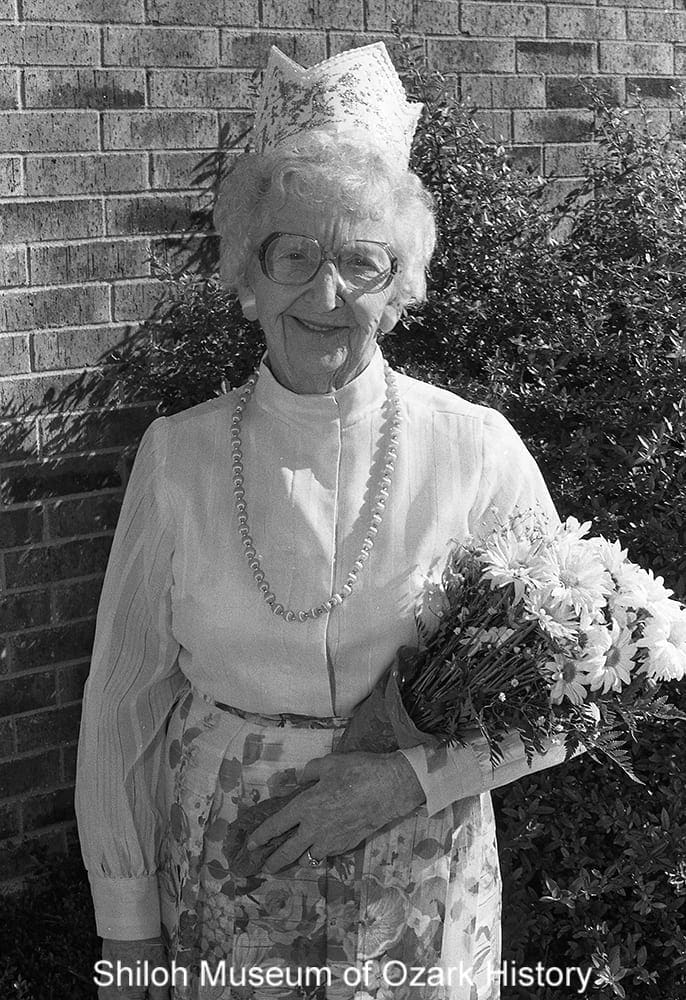
Grace Julian, Ms. Senior Washington County 1988, Fayetteville, September 26, 1988. Springdale News Collection (SN 9-26-1988)
Ms. Senior Arkansas
The Ms. Arkansas Senior America Pageant began in 1986, a state offshoot of the national organization which started in 1980. During its first years, the state contest was held in Harrison. Today, the judging categories are formal wear, talent contest, interview, and philosophy of life. Contestants have to be sixty-years in age or older, and must not be former state queens.
In 1988, Grace Julian of Springdale was crowned Ms. Senior Washington County during a pageant held at the Sang Senior Center in Fayetteville. The following month she competed in the statewide contest, “for ladies sixty and over who have ‘reached the age of maturity and elegance.’” Although she did not win, years later another Northwest Arkansas woman did—Constance May Waddell of Bella Vista was named Ms. Senior Arkansas 1996.
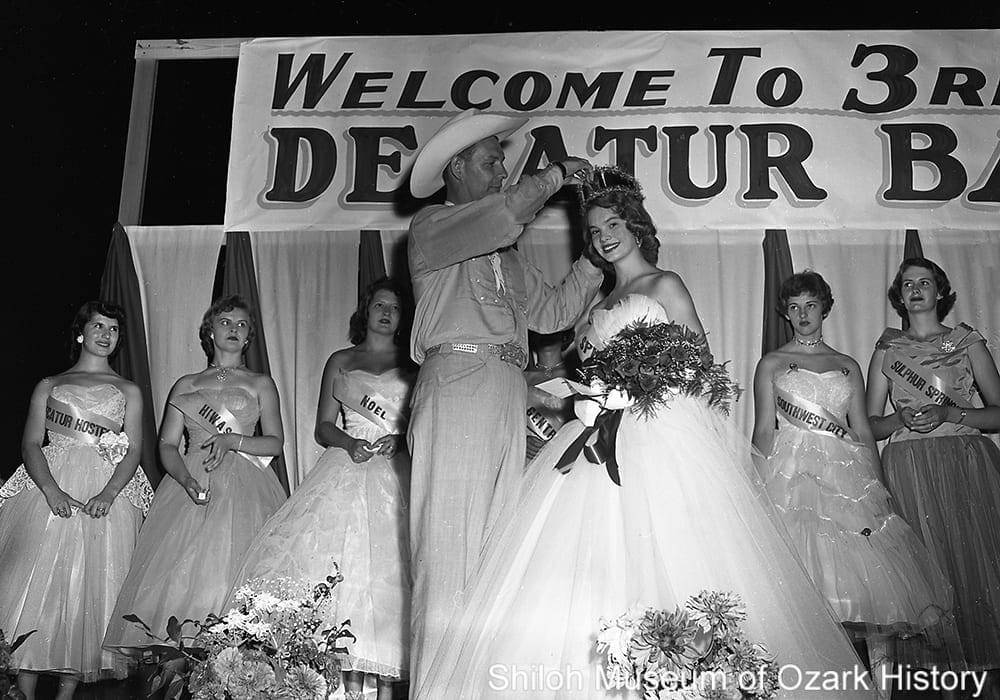
Judy Eoff, Miss Decatur Barbecue 1956, being crowned by musician Leon McAuliffe, Decatur, August 2, 1956. She received a $25 savings bond as a prize. The other young women were given a ticket to the chicken dinner. Northwest Arkansas Times Collection (NWAT Box 5 56-8.49)
Miss Decatur Barbecue
When the small town of Decatur lost its only poultry-processing plant in the early 1950s, most of its citizens moved away to find new work. Community leaders built their own plant to bring new prosperity to the town. In 1953 Decatur took first place in the state’s “towns under 1,000” category. To celebrate, a Homecoming Barbecue was held, complete with chicken dinners, an equestrian (horse) team display, “Indian dancing,” and a concert by Leon McAuliffe and His Cimarron Boys. Two contests were held, Tiny Tots and Miss Decatur Barbecue. The following year the National Municipal League named the town an “All-American City,” leading city officials to make the barbecue an annual event.
Many Northwest Arkansas towns sent a contestant. In the early years, the pageant included ballgown and swimsuit competitions. Nowadays the young women compete in formal and casual wear and are asked questions about their favorite food, hobby, song, color, and animal. When Desi Meek won in 2018, she was slated to be the last to wear the crown. The Decatur Chamber of Commerce intended to end the pageant because so few girls were participating. Plus, two-thirds of the contest winners weren’t from Decatur. Following a month-long debate, the Chamber decided to continue, limiting the contest to young women who were students at one of three area high schools.
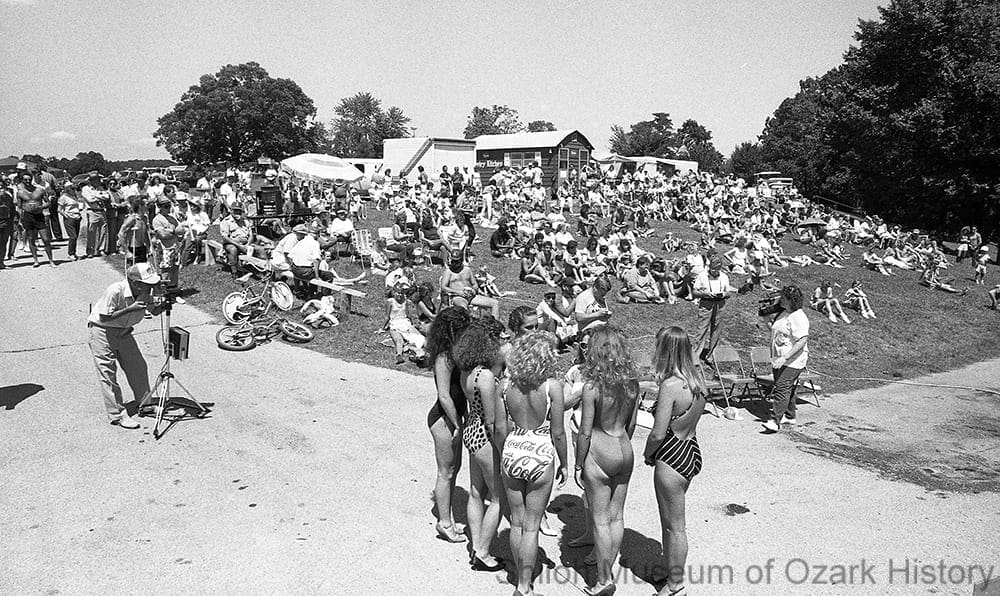
Miss Beaver Lake contestants stand before the cameras and the crowd, Horseshoe Bend, August 29, 1987. Stacy Malone of Bentonville (2nd from right) was crowned winner. Mark Neil, photographer. Springdale News Collection (SN 8-29-1987
Miss Beaver Lake
The Beaver Lake Water Festival began in 1966 at Beaver Shores. Geared as family entertainment, it featured water-skiing contests, motor-boat races, log-rolling contests, a skydiving show, barbecue, and a fireworks display. The Miss Beaver Lake contest was added to the program in 1968, the event’s third year. The festival was put on by several different organizations over the years, including the Springdale Moose Lodge in the early 1980s, when the festival was held at Horseshoe Bend.
The age-range of contestants spanned from sixteen to twenty-three, depending on the year. For many years the pageant was a swimsuit competition—“No talent presentation . . . required.” The 1971 winner received a trophy, gift certificates from merchants, $100 in cash, and the use of a new Plymouth car for a week. The contest lasted until at least 1991, when participants were judged for poise, personality, talent, and stage appearance.
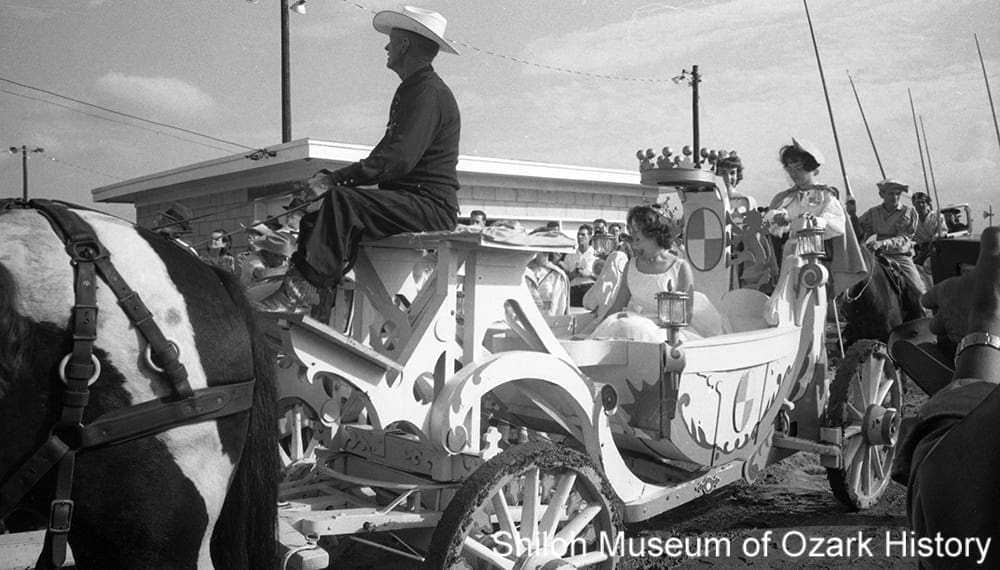
Joy Patrick, Crossbow Queen 1961, being driven into the arena to crown the 1962 queen, Charlotte McBee, Huntsville, October 14, 1962. With Ed Reed (driver) and Crossbowettes Diane McKinney (back of coach, left) and Shirley Duncan. Pat Donat, photographer. Northwest Arkansas Times Collection (NWAT Box 106, D-62.10)
Crossbow Queen
At the urging of Huntsville’s community leaders, George Stevens of Marcella, Arkansas, inventor of the repeating crossbow (a Medieval weapon which shoots an arrow), came to Huntsville in 1958 to create a tourism opportunity for the town. His crossbow tournament featured shooting contests, daredevil horseback-riding competitions by the Lancers, a group of costumed members of local riding clubs, and a demonstration by the Crossbowettes, a team of girls from Huntsville High School who performed precision drills and specialty tricks such as shooting backwards at targets, aided by a tiny mirror.
Stevens established the Crossbowettes in part to take advantage of their youthful beauty to attract visitors. Each year a young woman was selected as queen. Before her coronation, she was driven into the arena in an elaborate horse-drawn carriage, escorted on horseback by the Lancers and the Crossbowettes. Most of the queens were Crossbowettes, chosen by the young women themselves. But dwindling attendance couldn’t justify the effort it took to run the pageantry portion of the tournament. The last queen was crowned in 1967. The crossbow contests themselves continued until 2003.
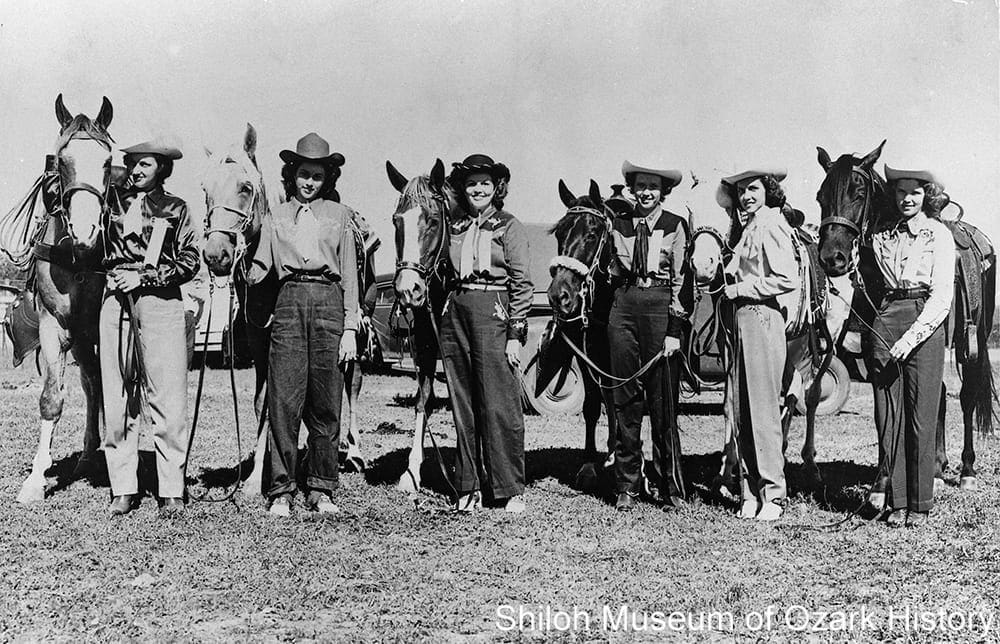
Rodeo queens including Pat Locke, Miss Rodeo of the Ozarks 1949 (3rd from right) and Pat Parsons, Miss Rodeo of the Ozarks 1950 (far right), Parsons Stadium, Springdale, July 1951. Washington County History Book Collection (S-90-21N240.21)
Miss Rodeo of the Ozarks
The Rodeo of the Ozarks began in 1945, just as World War II was winding down. After two enthusiasts suggested that Springdale hold its own rodeo, Thurman “Shorty” Parsons and Dempsy O. Letsch agreed to take on the task. Early rodeos featured ropers and riders, parades, and a traveling caravan of “hillbilly” comedy and music to entice attendees. The first Miss Rodeo of the Ozarks was Lois Wilson in 1946. In the beginning, local horsewomen and members of area riding clubs competed for the title. In later years, outsiders were allowed to compete on their quest to become Miss Rodeo USA.
A member of the Siloam Springs Riding Club, Lindsey Thompson of Oklahoma became Miss Rodeo of the Ozarks 2018. She and the other contestants were judged by “personality….interviews, modeling and fashion, horsemanship and speech…[and] their ability to greet and mingle with fans…” By 2018, the pageant’s director, eighty-five-year-old Pat Parsons Hutter, had been on the job since 1958. One of her many duties was “taking [the girls] to breakfast every morning and getting them to bed by midnight.” As “Shorty” Parsons daughter and a Miss Rodeo of the Ozarks herself, she saw interest in the rodeo decline over the years. In 2014 only three women competed for the crown.
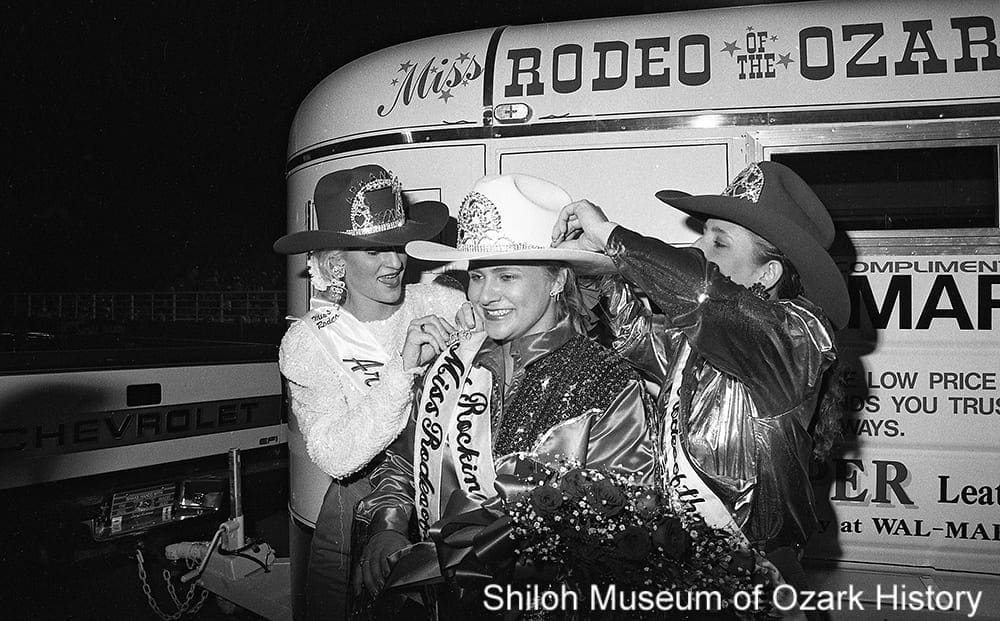
Sherri Ware (center), Miss Rodeo of the Ozarks 1991, Parsons’ Stadium, Springdale, July 4, 1990. With Julie Talkington (left), Miss Rodeo of the Ozarks 1990, and Mikki Skelton. Ware was formerly Miss Rocking W Ranch (Texas). Travis Doster, photographer. Springdale News Collection (SN 7-4-1990)
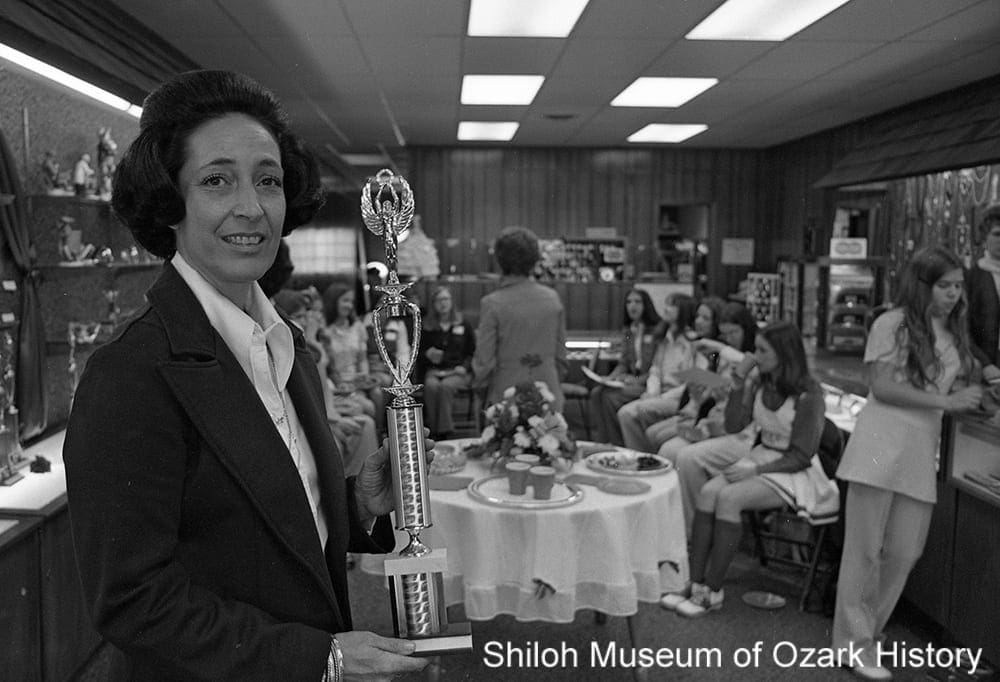
DeanE Walker and Miss Springdale High School candidates at Tatman’s Jewelry, Springdale, February 28, 1974. As a group, the girls were allowed to select the crown to be awarded each year. Springdale News Collection (SN 2-74 #13)
Queen of Queens
Former model DeanE Walker of Springdale was part of the pageant circuit from the late 1950s to the 1980s. A qualified official pageant judge, she ran a charm school which taught young women poise and fashion modeling. She also served as director of several pageants including Junior Miss, Northwest Arkansas Poultry Princess, Miss Washington County, and Miss Springdale High School. The latter competition began in 1959 as a way to help pay for the school’s annual yearbook. Walker said the contest’s advisory board chose “ . . . girls who have a variety of talents and would look good on stage. After all, this is a money-raising project, so we have to please the public.” In 1974 she told contestants that they were not allowed to wear “ . . . full wigs, jewelry or gowns with sleeves or rhinestones, and must wear elbow-length gloves during the pageant.” No mothers were allowed backstage.
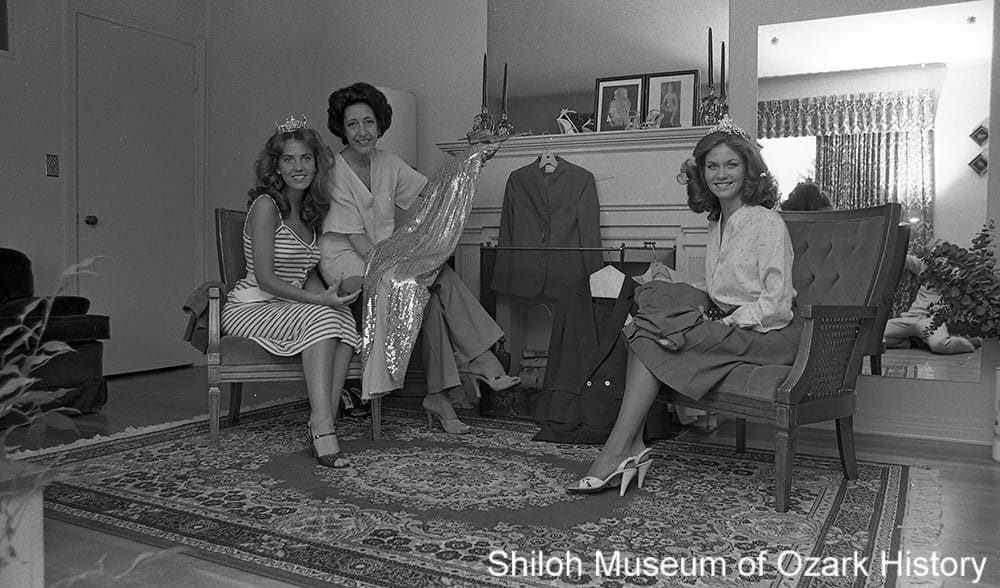
DeanE Walker (center) reviews pageant clothes with contestants getting ready for the Miss Arkansas 1980 pageant, Springdale, June 26, 1980. With Kathy Higgins (left), Miss Washington County 1980, and Regina Hopper, Miss University of Arkansas 1980 (later Miss Arkansas 1983). Mark Neil, photographer. Springdale News Collection (SN 6-26-1980)
Credits
Alison, Charlie. Emails with Shiloh Museum staff re: African-American homecoming queens and Miss University of Arkansas contestants, June 2020.
Briggs, Rick. “Springdale Poultry Festival Cancelled.” Springdale News, 3-6-1977.
Davies, David. “Early Tontitown Days Recalled.” Northwest Arkansas Times, 8-14-1982.
DeMarco, Iman. “DeMarco’s Diary.” Miss Gay Arkansas America, 12/2019. (accessed 6/2020)
Eckles, Mike. “Barbecue has rich tradition.” Westside Eagle Observer, 7-1-2013.
________ “Fayetteville woman crowned 2017 Miss Decatur Barbecue.” Westside Eagle Observer, 8-9-2017.
________ “Meek returns to crown Miss Decatur Barbecue.” Westside Eagle Observer, 7-31-2019.
________ “New Miss Decatur Barbecue to be crowned Saturday.” Westside Eagle Observer, 8-1-2018.
________ “Sara Garner to turn crown over to new Miss Decatur Barbecue.” Westside Eagle Observer, 8-2-2017.
Chicken-of-Tomorrow Souvenir Program, June 11-16, 1951. Shiloh Museum of Ozark History Collection.
Hall, Kay B. “First Queen Remembers Early Grape Festivals.” Springdale Morning News, 8-14-1992.
Harrison, Eric. E. “Pandemic puts pageants onhold.” Northwest Arkansas Democrat-Gazette, 5-9-2020.
Havel, O’Dette. “Contest Was No Cockamamie Notion,” University Reflections. University of Arkansas, Spring 1993.
Hightower, Lara. “Pat Parsons Hutter.” Arkansas Democrat-Gazette, 6-24-2018. (accessed 6/2020)
Hinshaw, Jerry, with Lloyd McConnell and John I. Smith. “The Washington County Fair 1856-1976.” Washington County Fair 1856-1976 program, September 1976.
Holsted, David. “Dairy Princess treated like royalty.” Harrison Daily Times, 9-26-2019.
Jines, Billie. “Grape Festival Dates Back to 1899.” Springdale News, 8-12-1964.
Kurtz, Glory Ann. “Alice Walton Realigning Priorities—Holding Complete Dispersal.” Equi-Voice, 7-20-2015, updated 7-22-2015. (accessed 6/2020)
Madison County Record. “First Red Cross Quota Reached; Second Short.” 4-10-1952.
_______ “Harrison to Host Second Ms. Senior Arkansas Pageant.” 9-24-1987.
_______ “June 26, 2014: A crowning achievement: Hindsville native named Miss Arkansas 2014.” 9-19-2019.
_______ “Ms. Senior Arkansas Pageant Set For March 30.” 3-28-1996.
_______ “Ramirez Winn Talent Contest.” 10-17-1991.
_______ “Twelve Compete For Miss Beaver Lake Title.” 7-28-1983.
_______ Untitled photo of Janis Barnes, American Honey Queen 1968, 3-14-1968.
McKiever, Tonya. “Miss Benton County Fair Pageant set for first night.” Benton County Daily Record, undated (September 2007).
Miss Gay Arkansas America. “Miss Gay Arkansas America . . .” (accessed 6/2020)
Nolasco, Stephanie. “Miss America 2017 Savvy Shields ‘blacked out’ after winning the crown.” Fox News, updated 9-18-2017. (accessed 6/2020)
Northwest Arkansas Times. “3rd Annual Beaver Lake Water Festival,” 8-28-1968.
_______ “ “28 Tiny Tots, 12 Senior Girls Entered in Contest To Choose ‘Miss Fayetteville.’”
_______ “5,000 Attend NWA Poultry Festival, Beauty Pageant at Springdale.” 5-28-1962.
_______ “Area Poultry Festival Begins Tomorrow.” 5-14-1965.
_______ “American Honey Queen Keeps Busy Schedule.” 9-6-1967.
_______ “Beauty Pageant In GAEBALE Is Dropped At UA.” 4-4-1972.
_______ “Beaver Lake Queen Named.” 9-7-1970.
_______ “Beaver Water Festival Set.” 8-11-1970.
_______ “Bentonville Girl Crowned County Fair Queen.” 9-17-1969.
_______ “Berryville Girl Named Honey Queen.” 1-29-1968.
_______ “Big Crowd Expected For Area Poultry Festival.” 5-12-1961.
_______ “Clara Webb is Named Miss Benton County.” 9-23-1964.
_______ “Committee Plans Dairy Princess Contest.” 4-21-1961.
_______ “Dairy Princess Contest to Be Held During Dairy Month.” 5-18-1961.
_______ “Dairy Princesses.” 9-9-1961.
_______ “Fayetteville Welcomes Its Junior Miss.” 5-8-1975.
_______ “Gaebale Scheduled This Weekend at University.” 4-25-1961.
_______ “Hairdo Helped Win Title, Says Miss Arkansas,” 7-24-1963.
_______ “Honey Queen [Linda Santa Cruze],” 10-9-1965.
_______ “Honey Queen [Linda Santa Cruze].” 2-10-1967.
_______ “Jaycees Open Search For ‘Miss Fayetteville.’” 4-15-1961.
_______ “Joyce Burnett Crowned Madison County Fair Queen.” 9-17-1964.
_______ “Julie Ann Wins Big!” 5-6-1975.
_______ “Long A Beekeeper, Poor Says It’s A Profession.” 3-26-1965.
_______ “Miss Fayetteville Contest Finalists Named.” 6-20-1952.
_______ “’Miss Huntsville’ To Be Named At Beauty Pageant.” 3-27-1952.
_______ “Miss Barnett To Serve Fair As Hostess Queen.” 8-14-1961.
_______ “Miss University of Arkansas Contestants.” 4-27-1973.
_______ “Negroes Picket Beauty Pageant.” 7-21-1969.
_______ “Pageants.” 4-11-1972.
_______ “Rogers Jaycees To Sponsor Beaver Lake Water Festival.” 9-3-1971.
_______ “Selection Of Miss Fayetteville Set For Tonight On U.A. Campus.” 5-8-1964.
_______ “Seventeen Coeds To Compete For Miss UA Title April 30.” 3-3-1969.
_______ “Shirley Franzmeier Crowned County Dairy Princess For ’65.” 5-8-2965.
_______ “Springdale Site Of Preliminary Beauty Contest.” 4-19-1961.
_______ “State Fair Queen.” 10-11-1976.
_______ “Talent Show Scheduled As Special Event.” 9-10-1962.
_______ “University Coed Wins Miss Arkansas Contest.” 7-23-1963.
_______ “Yes, Virginia, There Really Is A Miss University of Arkansas Pageant.” 5-6-1972.
_______ “Winning For Fayetteville.” 6-12-1950.
Owen, Rhonda. “Rodeo Queen.” Arkansas Life, 7-21-2014. (accessed 6/2020)
Springdale Benevolent Amusement Association. Rodeo of the Ozarks booklet, 1963.
Springdale News. “Chicken Cookers to Test Skills.” 5-17-1968.
_______ “Getting Ready” (re Higgins/Hopper Miss Arkansas). 7-1-1980.
_______ “Grape and Apple Festivals Staged Here.” 4-29-1937.
_______ “Grape Festival Will Be Held.” 4-17-1925.
_______ “Judy Eoff Wins ‘Miss Barbecue’ Contest at Decatur.” 8-3-1956.
_______ “Mark Munger, Kimberlee Campbell Winn Little Mr. And Miss Honors.” 3-20-1967.
_______ “Pageant Proves Successful Through Community Interest.” 2-28-1974.
_______ “Rodeo Winners Named; New Queen Crowned.” 7-5-1990.
_______ “Salute From the Vet.” 2-15-1991.
_______ “Springdale Off to Great Start in Bond Drive.” 11-11-1944.
_______ “Thompson earns another rodeo crown.” 8-8-2018.
University Libraries Digital Collections. “BAD Times Collection.” University of Arkansas. (accessed 6/2020)
University of Arkansas News. “Remembering Donna Axum Whitworth: Miss America, Lifelong U of A Supporter.” 6-12-2020. (accessed 6/2020)
_______ “University Libraries Opens Collections from Black Americans for Democracy Student Group.” 2-28-2012.

